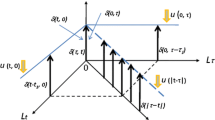Abstract
A new technique is developed that extends the normal Bode plots from two-dimensional to three-dimensional, including the \(\sigma \) axis into the plots. By utilizing MATLAB, it is shown how the Bode plots of a transfer function in an analog circuit can turn into a 3D Bode surface. In general, a tool is developed that integrates WinSpice and MATLAB so that in a comprehensive AC analysis Bode surfaces are directly generated for any given circuit transfer function. The technique is shown to be ideal to identify, and hence subsequently to extract, the poles and zeros of a transfer function. The applications can be extended into exploring feedback theory, analog filter design and stability analysis of control systems in high-performance circuits. Examples particularly for analog CMOS circuits are worked out that demonstrate some of the capabilities of the tool.










Similar content being viewed by others
Notes
\(\mathrm{}_{i}(\mathrm{t})\) or \(\mathrm{q}_{o}(\mathrm{t})\) can represent either voltage or current.
References
R.J. Baker, CMOS, Circuit Design, Layout, and Simulation, 2nd edn. (IEEE Press, Piscataway, 2008)
O. Guerra, J.D. Rodríguez-García, F.V. Fernández, A. Rodríguez-Vázquez, A symbolic pole/zero extraction methodology based on analysis of circuit time-constants. Analog. Integr. Circuits Signal Process. 31(2), 101–118 (2002)
R. Hashemian, S-Plane Bode Plots—Identifying Poles and Zeros in a Circuit Transfer Function, in Proceedings of the IEEE LASCAS 2015 Conference, Montevideo, Uruguay (February 24–27, 2015)
R. Hashemian, Extraction of poles and zeros of an RC circuit with roots on the real axis. IEEE Trans. Circuits Syst. II Exp. Br. 61(8), 624–628 (2014)
E. Hennig, Matrix approximation techniques for symbolic extraction of poles and zeros. Analog. Integr. Circuits Signal Process. 31(2), 81–100 (2002)
MATLAB Symbolic Toolbox, MathWork. http://texas.math.ttu.edu/~gilliam/ttu/mlhtml_1/symbolic/symbolic.html
G. Nebel, U. Kleine, H.-J. Pfleiderer, Symbolic pole/zero calculation using SANTEFE. IEEE J. Solid-State Circuits 30(7), 752–761 (1995)
T.L. Pillage, R.A. Rohrer, C. Visweswariah, Electronic Circuit and System Simulation Methods (McGraw-Hill Inc, New York, 1995)
Pole zero locations in MATLAB, MathWorks. http://www.mathworks.com/help/control/ug/pole-and-zero-locations.html
M. Smith, WinSpice 3 User’s Manual, SPICEMAN (May 4, 2006)
Author information
Authors and Affiliations
Corresponding author
Rights and permissions
About this article
Cite this article
Hashemian, R., Vanga, M. & Rahat, M. Identifying and 3D Displaying Poles and Zeros in Analog Circuit Transfer Functions: Bode Surfaces. Circuits Syst Signal Process 36, 2473–2485 (2017). https://doi.org/10.1007/s00034-016-0418-0
Received:
Revised:
Accepted:
Published:
Issue Date:
DOI: https://doi.org/10.1007/s00034-016-0418-0




